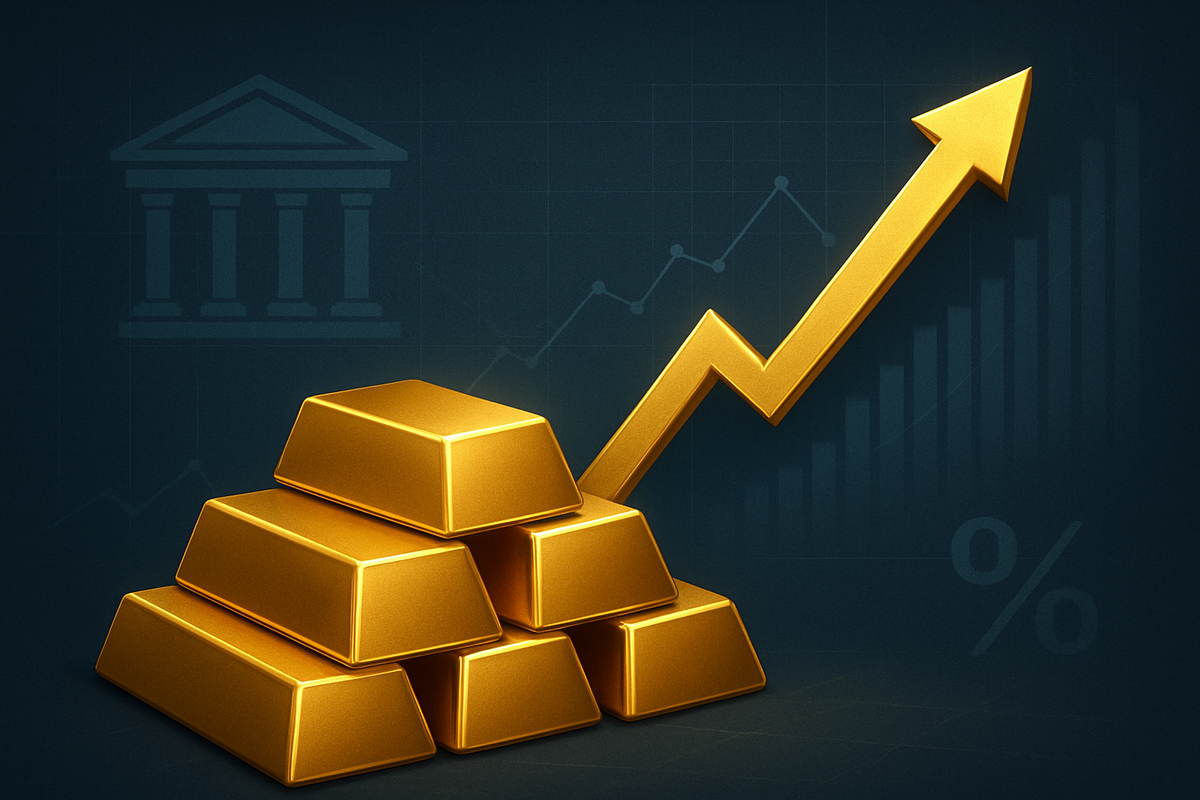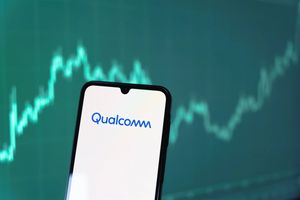
Gold prices are currently experiencing an extraordinary surge, nearing the $4,000 per ounce mark as of November 7, 2025, driven by a powerful confluence of factors: the unwavering expectation of Federal Reserve interest rate cuts, a weakening U.S. dollar, and a sustained, robust appetite for the precious metal from global central banks. This remarkable ascent, seeing gold appreciate over 50% since the beginning of the year and hitting an all-time high exceeding $4,380 per ounce in October 2025, signals a profound shift in market sentiment and investor strategy, highlighting a growing preference for tangible assets amidst economic uncertainties.
The immediate implications of this rally are far-reaching, pointing to a broader lack of confidence in traditional dollar-denominated assets and a re-evaluation of risk across various asset classes. As investors flock to gold, it underscores persistent inflationary pressures and contributes to a "risk-off" sentiment that is beginning to permeate across sectors, potentially impacting technology shares while creating a boom for gold mining companies. The market remains in a consolidation phase after recent volatility, with analysts now revising gold price targets upwards, some even forecasting a potential reach of $5,000-$5,600 by 2026 if the anticipated Federal Reserve rate cuts materialize.
Unpacking the Golden Rush: A Deep Dive into Market Drivers
The current gold rally is fundamentally underpinned by specific expectations regarding the U.S. Federal Reserve's monetary policy, particularly the anticipation of further interest rate reductions. Market forecasts suggest the Fed funds rate could settle around 3.6% by the end of 2025 and 3.4% by 2026, implying at least 100 basis points of cuts from September 2025 levels. The Federal Open Market Committee (FOMC) already initiated this easing cycle with a 25-basis-point cut in October 2025, bringing the federal funds rate to a range of 3.75-4.00%. Despite some cautious remarks from Fed Chair Jerome Powell in October, market pricing still indicates a significant probability of another 25-basis-point cut in December, with major institutions like Goldman Sachs Research forecasting a "quite likely" move.
This dovish outlook from the Fed is a primary catalyst, as lower interest rates diminish the opportunity cost of holding non-yielding assets like gold, making it a more attractive investment compared to interest-bearing alternatives. Concurrently, a weakening U.S. dollar, often a direct consequence of anticipated rate cuts, further bolsters gold's appeal for international investors by making it cheaper to purchase in other currencies. This dynamic has been a consistent driver throughout the year, reinforcing gold's traditional role as a reliable store of value.
Beyond the Fed's anticipated actions, global central banks have emerged as significant and consistent drivers of gold demand. These institutions have been strategically accumulating the precious metal, even amidst its record-high prices. In the third quarter of 2025 alone, net gold purchases by central banks amounted to approximately 220 tons, a 28% increase from the previous quarter. Year-to-date, central banks have added a substantial 634 tons to their reserves, a figure that, while slightly below the record levels of the past three years, still significantly surpasses the pre-2022 annual average. Key buyers include emerging market central banks such as Kazakhstan, Brazil, and Turkey, with Poland (WSE: PLGOLD) notably increasing its gold holdings and aiming to raise gold's share in its foreign reserves from 20% to 30%. This sustained buying reflects a strategic move to diversify reserves away from dollar-denominated assets, driven by global economic uncertainties and geopolitical tensions.
The timeline leading up to this moment has seen gold steadily climb throughout 2025, punctuated by key events such as the October 2025 Fed rate cut and ongoing signals of a potentially more accommodative monetary policy. Initial market reactions have been overwhelmingly bullish for gold and precious metals, with investors seeking safe havens. However, this has also led to a more cautious sentiment in other sectors, particularly technology, as a "risk-off" environment begins to take hold. Debates within the Fed itself, concerning inflation drivers like tariffs versus a cooling labor market, also contribute to the nuanced market volatility, keeping investors on edge for further policy cues.
Corporate Fortunes: Winners and Losers in the Golden Era
The sustained rally in gold prices, fueled by 'Fed Hopes' and central bank activity, creates a distinct bifurcation in corporate fortunes across various sectors. Unsurprisingly, gold mining companies are positioned as significant beneficiaries, experiencing a boom as their primary commodity commands higher prices. This directly translates to enhanced revenue streams, improved profit margins, and potentially increased capital expenditure in exploration and development. Companies like Barrick Gold Corp. (NYSE: GOLD), Newmont Corporation (NYSE: NEM), and Agnico Eagle Mines Ltd. (NYSE: AEM) are likely to see their stock valuations appreciate, driven by investor confidence in their future earnings potential. Higher gold prices also provide these miners with greater financial flexibility to manage debt, invest in operational efficiencies, or pursue strategic acquisitions, further solidifying their market positions.
Conversely, companies that rely heavily on discretionary consumer spending, particularly in sectors sensitive to inflationary pressures or a "risk-off" investment environment, might face headwinds. While not directly impacted by gold prices, the underlying economic conditions driving gold's ascent—inflationary concerns and a weakening dollar—can erode consumer purchasing power and shift investment away from growth stocks towards safer assets. Retailers, hospitality, and certain technology companies, especially those with high valuations predicated on aggressive growth projections, could experience a contraction in demand or a decrease in investor appetite. Furthermore, any companies with significant debt denominated in a weakening U.S. dollar could see their debt burden effectively decrease, but this would be overshadowed by broader economic slowdowns if the Fed's actions are a response to a struggling economy.
The financial sector also faces a complex scenario. While a weakening dollar might benefit some international operations, sustained low interest rates, a key driver of gold's rally, can squeeze net interest margins for banks. Companies like JPMorgan Chase & Co. (NYSE: JPM) or Bank of America Corp. (NYSE: BAC) might find their profitability challenged in a prolonged low-rate environment, even if they benefit from increased trading activity in volatile markets. However, investment firms specializing in commodities or precious metals funds, such as Invesco Ltd. (NYSE: IVZ) or BlackRock Inc. (NYSE: BLK) through their ETF offerings like GLD, could see increased inflows and management fees as investors seek exposure to gold.
Moreover, industries that are significant consumers of gold, such as jewelry manufacturers or certain electronics producers, could face increased input costs. While some of these costs might be passed on to consumers, competitive pressures could force them to absorb a portion, impacting their profitability. Companies like Tiffany & Co. (NYSE: TIF), a subsidiary of LVMH, or various smaller jewelry retailers, would need to strategically manage their sourcing and pricing to mitigate the impact of higher gold prices. The overall sentiment of a 'risk-off' market also means that capital might flow out of riskier assets, affecting venture capital-backed startups and growth-oriented public companies that rely on consistent investor funding.
Wider Significance: A Paradigm Shift in Global Finance
The current gold surge is not merely a transient market event but rather indicative of a broader paradigm shift in global finance, deeply intertwined with evolving macroeconomic trends and geopolitical dynamics. This rally fits squarely into a trend of de-dollarization and diversification of reserves by central banks, a movement that has gained significant momentum in recent years. Central banks, particularly in emerging markets, are increasingly seeking to reduce their reliance on the U.S. dollar amidst concerns over global economic stability, inflation, and geopolitical tensions. Gold, as a universally recognized store of value independent of any single government's fiscal policy, serves as a crucial hedge against these uncertainties.
The potential ripple effects extend far beyond the precious metals market. A sustained weakening of the U.S. dollar, driven by anticipated Fed rate cuts, could have significant implications for global trade and investment. Countries holding substantial dollar reserves might see the value of those reserves diminish, potentially prompting further diversification efforts. This could accelerate the adoption of alternative currencies for international transactions and reduce the dollar's dominance as the world's primary reserve currency. For competitors and partners, this means a re-evaluation of currency exposure and hedging strategies, with a potential shift towards greater commodity-backed stability.
Regulatory and policy implications are also noteworthy. Governments and financial institutions may face renewed pressure to address inflationary concerns if gold's rally is indeed a signal of persistent price pressures. Central banks, while diversifying their own reserves, might also explore new frameworks for international monetary cooperation that account for a more multi-polar reserve system. The ongoing U.S. silver-tariff discussions, mentioned in the research, highlight how trade policies can intersect with precious metals markets, adding another layer of complexity for policymakers.
Historically, periods of significant gold appreciation have often coincided with economic uncertainty, high inflation, or geopolitical instability. The 1970s, characterized by oil shocks and high inflation, saw gold prices skyrocket after the collapse of the Bretton Woods system. More recently, the aftermath of the 2008 financial crisis and the subsequent quantitative easing measures also led to a substantial gold rally. The current environment, with its unique blend of post-pandemic inflationary pressures, ongoing supply chain disruptions, and escalating geopolitical tensions in various parts of the world, draws strong parallels to these historical precedents, reinforcing gold's role as a safe-haven asset. This event underscores a growing global distrust in fiat currencies and a return to fundamental value, suggesting that the drivers of this gold surge are deeply rooted and potentially long-lasting.
What Comes Next: Navigating the Golden Horizon
Looking ahead, the trajectory of gold prices will largely hinge on the actualization of 'Fed Hopes' and the continued strategic actions of central banks. In the short term, market participants will be meticulously scrutinizing every statement from Federal Reserve officials, particularly regarding the likelihood and timing of the anticipated December rate cut. If the Fed proceeds with a cut, or signals a more aggressive easing path for early 2026, gold could receive another significant boost, potentially pushing it towards the $4,200 mark by year-end. Conversely, any hawkish surprises or a delay in rate cuts could trigger short-term volatility and a temporary pullback, as investors reassess their positions. The market will also be watching for further weakening of the U.S. dollar, which would provide additional tailwinds for gold.
In the long term, the outlook for gold appears robust. The underlying drivers—persistent global economic uncertainties, geopolitical fragmentation, and the ongoing trend of central bank diversification—are structural rather than cyclical. This suggests that even if the Fed's easing cycle is less aggressive than currently anticipated, gold's appeal as a safe haven and a hedge against inflation and currency debasement will likely endure. Potential strategic pivots for investors and corporations include increasing allocations to precious metals as a core component of diversified portfolios, and for mining companies, a focus on optimizing operations and expanding reserves to capitalize on sustained high prices.
Market opportunities are likely to emerge in related sectors. Exchange-Traded Funds (ETFs) backed by physical gold, such as the SPDR Gold Shares (NYSEARCA: GLD), will likely continue to attract significant investor capital. Furthermore, companies involved in gold exploration and development, particularly those with strong balance sheets and promising projects, could become attractive acquisition targets or see increased investment. Challenges may arise for industries heavily reliant on a stable, strong U.S. dollar or those susceptible to inflationary pressures, requiring them to adapt their business models and supply chain strategies.
Potential scenarios range from a continued, steady ascent for gold, if the Fed delivers on its dovish promises and central bank buying persists, to periods of consolidation and moderate pullbacks if economic data provides reasons for the Fed to pause or reverse course. An extreme scenario, though less likely, could involve a rapid acceleration if a major geopolitical event or severe economic downturn triggers a massive flight to safety. However, the prevailing sentiment points towards gold maintaining its elevated status, with analysts forecasting a potential reach of $5,000-$5,600 by 2026, underscoring its enduring significance in the evolving global financial landscape.
Comprehensive Wrap-up: Gold's Enduring Allure in a Shifting World
In summary, gold's remarkable ascent to near $4,000 per ounce as of November 7, 2025, is a powerful testament to the market's conviction in impending Federal Reserve interest rate cuts and the unwavering demand from global central banks. The 'Fed Hopes' for a more dovish monetary policy, coupled with a weakening U.S. dollar, have significantly lowered the opportunity cost of holding the non-yielding asset, making it an irresistible magnet for investors seeking refuge from economic uncertainties and inflationary pressures. Concurrently, the strategic diversification efforts of central banks, particularly those in emerging markets, underscore a fundamental shift away from dollar-denominated assets towards tangible stores of value.
Moving forward, the market is poised for continued vigilance. Investors will be closely monitoring the Federal Reserve's actions, with particular attention to the December rate decision and subsequent guidance. The sustained buying appetite from central banks, alongside geopolitical developments and broader macroeconomic indicators, will also play a crucial role in shaping gold's trajectory. While short-term volatility is always a possibility, the long-term outlook for gold appears robust, supported by structural shifts in global finance and an enduring appeal as a safe-haven asset.
The lasting impact of this gold rally is likely to be a reinforced belief in the precious metal's role as a hedge against systemic risk and currency debasement. It signals a potential recalibration of global reserve assets and a growing preference for tangible wealth in an increasingly unpredictable world. Investors should watch for further clarity on the Fed's rate path, continued central bank purchasing trends, and any significant shifts in global geopolitical stability. The current golden era is not just a fleeting market phenomenon; it's a profound indicator of deeper changes underway in the financial world, making gold an asset of paramount importance in the coming months and years.
This content is intended for informational purposes only and is not financial advice

















